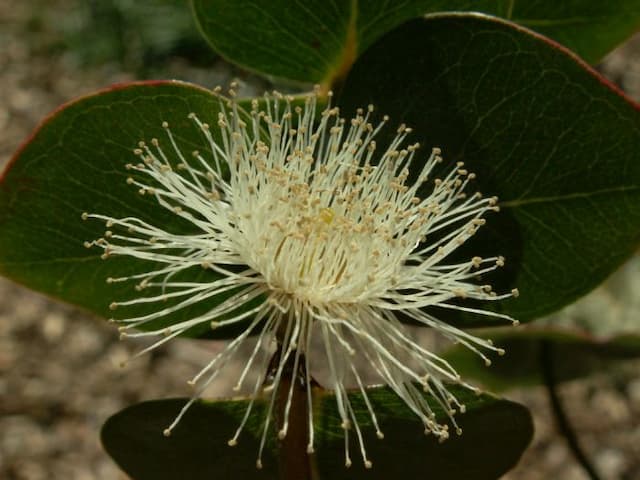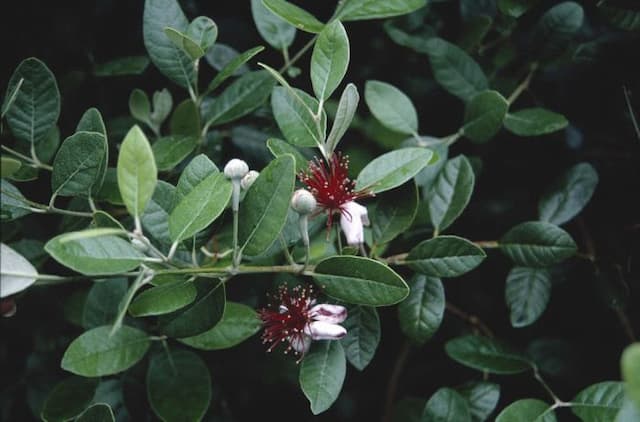Urn Gum Eucalyptus urnigera

ABOUT
Commonly known as urn gum, Eucalyptus urnigera is an appealing evergreen tree recognized by its smooth, cream-colored bark that often peels in ribbons to reveal greyish patches underneath. The foliage consists of oval or heart-shaped juvenile leaves which are a bright, glossy green and transition to more elongated and sickle-shaped adult leaves as the tree matures. During its flowering season, it displays white flowers which are small and arranged in clusters. The flowers give way to the urn-shaped seed capsules that are woody and can persist on the branches. The overall appearance conveys a picturesque quality, commonly found in cold, temperate climates, and it adds an elegant touch to the landscape with its pale bark and contrasting green foliage.
About this plant
 Names
NamesSynonyms
Urn Gum, Urn-fruited Eucalyptus, Urn-shaped Eucalyptus
Common names
Eucalyptus urnigera.
 Toxicity
ToxicityTo humans
Eucalyptus urnigera, commonly known as Urn Gum, contains compounds that can be toxic to humans if ingested. The oil, which is distilled from the leaves, is especially potent and can cause poisoning. Symptoms of Eucalyptus poisoning include stomach pain, vomiting, diarrhea, dizziness, feelings of suffocation, and weakness. In severe cases, ingestion of eucalyptus oil may lead to central nervous system depression and potentially be fatal.
To pets
Urn Gum is toxic to pets if ingested. The essential oils and compounds, such as eucalyptol, found in the leaves can cause various symptoms including salivation, vomiting, diarrhea, depression, and weakness. In large enough amounts, Eucalyptus can be neurotoxic, leading to seizures and potentially death. It is important to prevent pets from chewing on any part of this plant.
 Characteristics
CharacteristicsLife cycle
Perennials
Foliage type
Evergreen
Color of leaves
Green
Flower color
White
Height
40 feet (12 meters)
Spread
25 feet (7.6 meters)
Plant type
Tree
Hardiness zones
8
Native area
Australia
Benefits
 General Benefits
General Benefits- Landscape Aesthetics: Eucalyptus urnigera, commonly known as urn gum, can add beauty to gardens and landscapes with its attractive bark and evergreen foliage.
- Habitat Support: The tree provides habitat and food sources for various wildlife, especially birds and insects.
- Shade Provider: Urn gum trees can offer significant shade in sunny climates, creating cooler micro-environments.
- Windbreak: With its tall and straight growth, urn gum can serve as a windbreak, protecting smaller plants and reducing soil erosion.
- Wood Production: The timber of urn gum is valued for its strength and durability, suitable for construction, furniture, and craftwork.
- Aromatic Foliage: The leaves of urn gum are aromatic, which can add a pleasant fragrance to the surrounding area.
- Recreational Use: Eucalyptus urnigera forests are often used for recreational activities like hiking and bird watching.
 Medical Properties
Medical Properties- Antimicrobial: The essential oils extracted from Eucalyptus urnigera are known to have antimicrobial properties, which may be effective against certain bacteria, fungi, and viruses.
- Decongestant: Compounds found in the eucalyptus leaves can help in relieving nasal congestion commonly associated with colds and respiratory infections.
- Anti-inflammatory: Some components of Eucalyptus urnigera, such as eucalyptol (1,8-cineole), have anti-inflammatory effects which can provide relief for inflammation-related conditions.
- Expectorant: The plant’s extracts can be used to aid in the expulsion of phlegm and mucus from the respiratory tract, providing relief for those with coughs.
- Analgesic: There may be some pain-relieving properties associated with the use of Eucalyptus urnigera, though this is less documented and utilized than other properties.
- Antispasmodic: The oils of the plant may have antispasmodic effects, which can reduce muscular spasms and relax smooth muscles.
 Air-purifying Qualities
Air-purifying QualitiesThis plant is not specifically known for air purifying qualities.
 Other Uses
Other Uses- Eucalyptus urnigera is sometimes used in the production of honey, as the flowers provide nectar for bees.
- In crafting, the wood of the plant can be turned into small objects like buttons, beads, and ornaments, taking advantage of its fine grain and workability.
- In the art world, artists use leaves of Eucalyptus urnigera to create unique eco-prints on fabric or paper, yielding beautiful patterns and designs.
- Landscape designers often utilize Eucalyptus urnigera for its ornamental value, adding it to gardens for its attractive bark and foliage.
- Due to its fast growth, the plant is utilized in reforestation projects and for reclaiming degraded landscapes.
- Woodworkers sometimes use the timber for making musical instruments like guitars or woodwind instruments, due to its acoustic properties.
- The bark of Eucalyptus urnigera is used in crafting for creating natural textures in home decor items and wall art.
- In some cultures, the leaves are used in ceremonies and are woven into wreaths or garlands as symbols of remembrance.
- The robust nature of the wood makes it suitable for outdoor construction, like garden beds or retaining walls, where rot resistance is important.
- Eucalyptus urnigera is incorporated into natural dyeing processes, where the leaves yield a range of colorfast dyes for textiles from subtle greens to yellows.
Interesting Facts
 Feng Shui
Feng ShuiEucalyptus is not used in Feng Shui practice.
 Zodiac Sign Compitability
Zodiac Sign CompitabilityEucalyptus is not used in astrology practice.
 Plant Symbolism
Plant Symbolism- Healing and Protection: Eucalyptus urnigera, commonly known as the Urn Gum, is often associated with healing due to its medicinal properties. Essential oils derived from eucalyptus leaves are used in remedies for respiratory ailments, making it symbolic of protection against illness.
- Refreshment and Clarity: The clean, crisp scent of the Urn Gum is believed to clear the air and the mind, symbolizing fresh starts and mental clarity.
- Endurance and Resilience: Eucalyptus trees are known for their ability to survive in tough conditions, representing endurance and the ability to withstand life’s challenges.
 Water
WaterThe Eucalyptus urnigera, commonly known as Urn Gum, prefers to be kept in well-drained soil and should be watered thoroughly, but infrequently. Initially, water the young trees once a week with about 1 to 2 gallons, depending on the size of the tree and the weather conditions. Once established, they are fairly drought tolerant and will require less frequent watering, about once every two to four weeks or even less often, depending on the climate. It is important not to over-water as it can lead to root rot. Always check the soil moisture before watering; the soil should be dry a few inches down before you water again.
 Light
LightUrn Gum thrives best in full sunlight, receiving at least six hours of direct, unfiltered sunlight per day. It is ideal to position the tree in a location where it gets ample morning light and some partial shade in the afternoon, especially in hotter climates. However, Eucalyptus urnigera can tolerate and do well in constant full sun exposure throughout the day.
 Temperature
TemperatureUrn Gum prefers a temperate climate and can tolerate a temperature range between 20°F and 90°F. Frost-hardy, the Urn Gum can survive short periods of colder winter temperatures down to about 10°F but sustained cold can be detrimental. The ideal temperature for the Eucalyptus urnigera is between 60°F and 80°F, which promotes the best growth and health for the tree.
 Pruning
PruningPruning the Urn Gum tree is generally done to shape the tree, remove dead or damaged limbs, and encourage healthy growth. Pruning should be done in late winter or early spring before new growth begins. It's recommended to prune the tree every two to three years, removing no more than 25% of the tree's canopy at a time to maintain its health and structure. Always use clean and sharp pruning tools to make clean cuts.
 Cleaning
CleaningAs needed
 Soil
SoilUrn Gum prefers well-drained, slightly acidic to neutral soil with a pH of 5.5 to 7.0. A mix of sand or perlite, peat, and loamy soil in equal parts can provide the right texture and nutrients for healthy growth. Ensure the potting mix is airy and does not retain excessive water to prevent root rot.
 Repotting
RepottingUrn Gum should be repotted every 2-3 years or when it becomes root-bound. Younger plants may need repotting more frequently to accommodate their rapid growth, while older, established trees may require less frequent repotting.
 Humidity & Misting
Humidity & MistingUrn Gum thrives in environments with moderate to low humidity levels. These plants are adapted to withstand drier conditions and do not require high humidity to grow well, replicating their native habitat in Tasmania.
 Suitable locations
Suitable locationsIndoor
Place in bright, indirect light, ensure good air circulation.
Outdoor
Full sun, shelter from harsh winds, well-drained soil.
Hardiness zone
8-10 USDA
 Life cycle
Life cycleEucalyptus urnigera, commonly known as urn gum, begins its lifecycle with seed germination, which occurs in favorable conditions of warmth and moisture, often after fire has reduced competition from other vegetation. The seeds develop into seedlings, which undergo a period of rapid growth characterized by the production of juvenile foliage, which is distinct from adult foliage in shape and sometimes color. As the seedlings mature into saplings, they continue to grow, establishing a strong root system and beginning to form a characteristic woody trunk. When the plant reaches maturity, it produces adult leaves, which are more drought and fire resistant, and begins the reproductive phase by flowering. The flowers of the urn gum are hermaphroditic, containing both male and female reproductive parts, and after pollination by birds, bees, or other insects, they develop into woody, urn-shaped capsules that release seeds when mature. The life cycle can continue with the germination of these seeds, or the mature tree can resprout from its lignotuber or epicormic buds after events such as bushfires, which are common in its native Australian habitat.
 Propogation
PropogationPropogation time
Spring to Summer
Eucalyptus urnigera, commonly known as urn gum, is commonly propagated from seed. The most popular method involves collecting seeds from mature capsules, which typically dry and release the seed in late summer or fall. To propagate urn gum from seed, the seeds should be sown on the surface of a well-draining seed raising mix, as they require light to germinate. A thin layer of the soil mix can be gently sprinkled over the seeds, but they should not be buried deeply. The container with the seeds needs to be kept moist, and ideally at a temperature of about 68°F (20°C), until germination occurs, which is usually within a couple of weeks. Once seedlings have developed several sets of leaves, they can be carefully transplanted into individual pots to grow on before being planted out in their permanent location.




